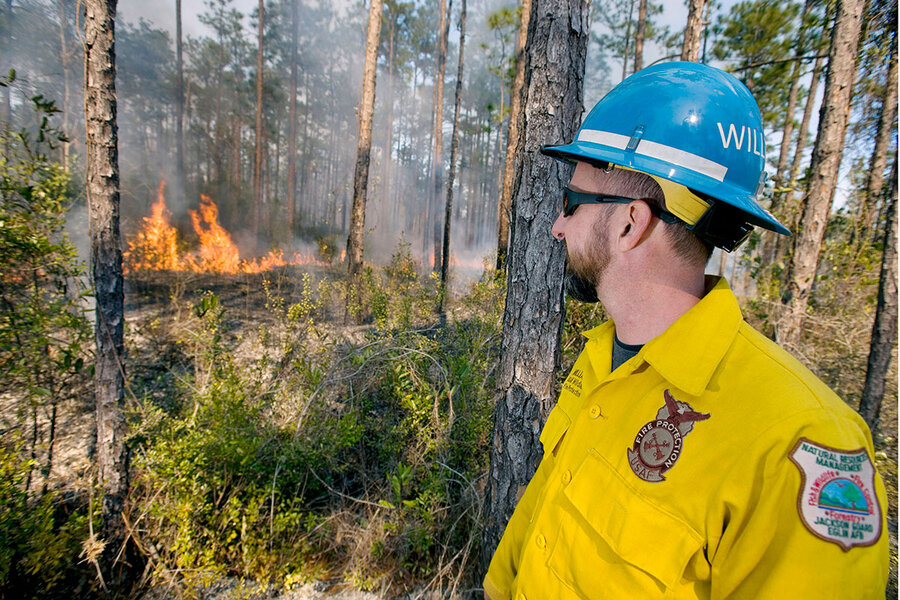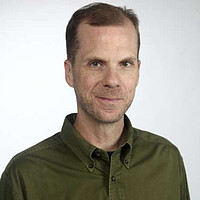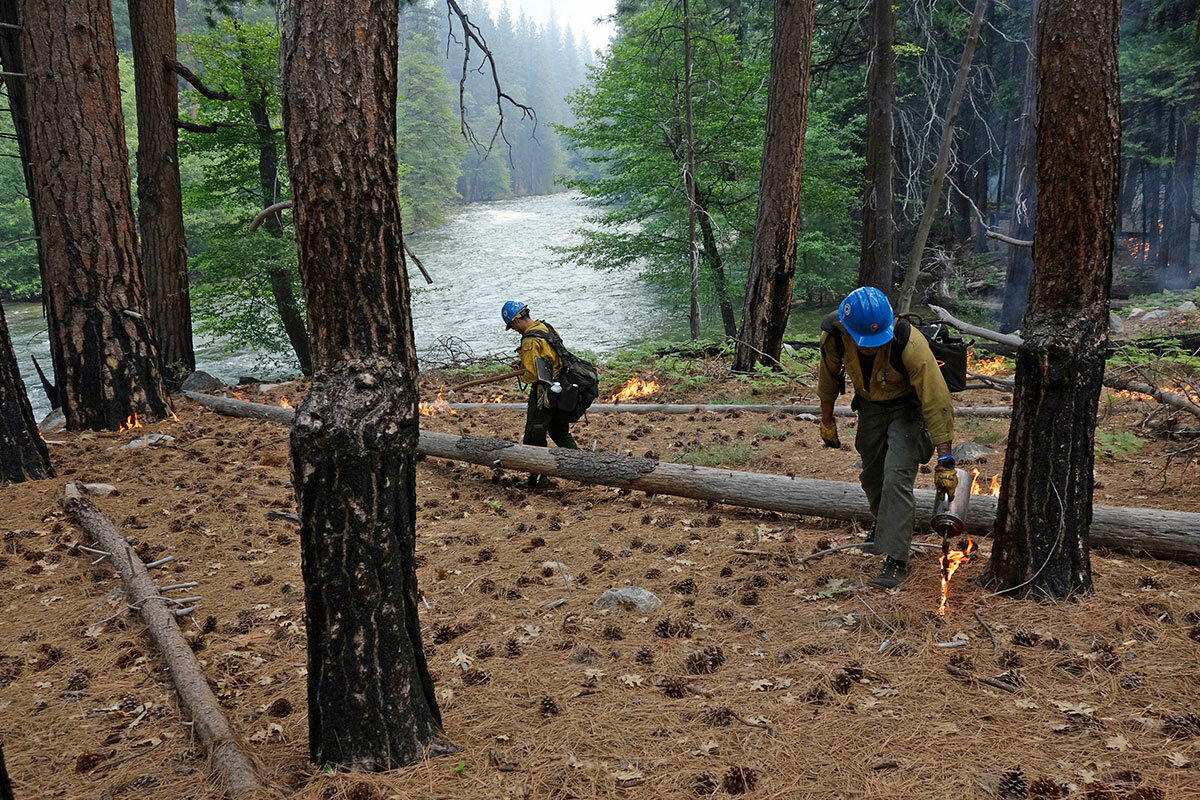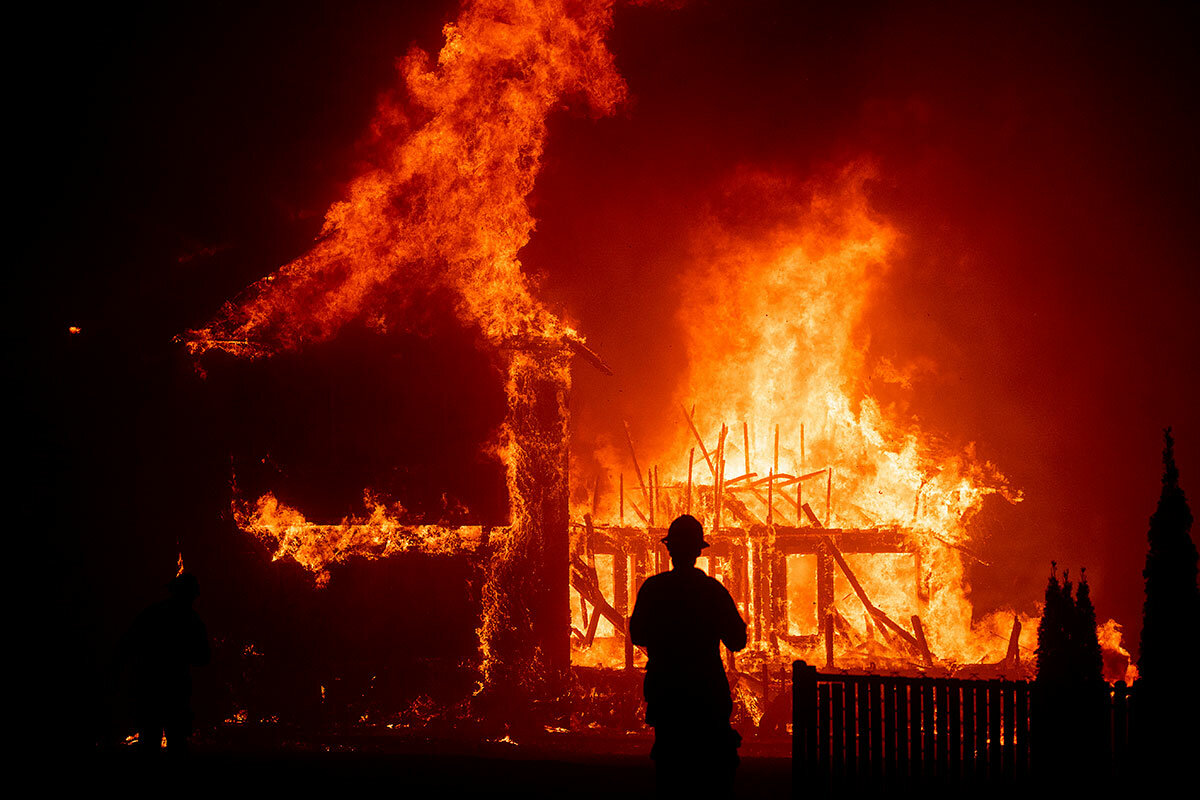Setting ‘good fires’ to reduce the West’s wildfire risk
Loading...
| Sacramento, Calif.
The wildfires burning across the American West for the past two months have scorched millions of acres of land and scarred the region’s collective psyche. As residents wait for the ashen air and ambient dread to lift, the devastation from Southern California to northern Washington has surpassed that of even the “Big Blowup” of 1910.
The weeks of uncertainty – marked by orange skies and lung-stinging smoke, emergency warnings and mass evacuations – have burdened people with acute fire fatigue. Or most people. As flames incinerate wide swaths of landscape, Jeremy Bailey suggests that the West needs more fire.
That’s right: more.
Why We Wrote This
As the West deals with a season of infernos, Florida may offer lessons. Officials there see fire of the right kind as a friend – and enlist public support for prescribed burns that sustain ecosystems and enhance public safety.
“When I wake up, I’m not thinking about where to put fire out. I’m thinking about where I can put fire on the ground,” says Mr. Bailey, director of the Nature Conservancy’s prescribed fire training program.
Prescribed burning involves setting fires on public or private lands under controlled conditions. The process targets brush, grasses, and other accumulated vegetation, along with dead and downed trees, to improve ecosystem health and reduce the fuels that power wildfires.
“Every day is a burn day,” says Mr. Bailey, a former longtime wildland firefighter who now teaches the practice of applying “good fire” to the land. “We just have to be smart about it.”
He and fellow prescribed fire advocates regard this season of infernos as a chance to reset the West’s approach to fire and forest management, with broad use of controlled burns to lower the region’s extreme wildfire risk and nurture resilient natural lands.
The prevailing strategy for managing wildfires emerged after the Big Blowup more than a century ago, when ferocious winds propelled fires across Washington, Idaho, and Montana. Three million acres burned as entire towns fell to the flames and at least 85 people died.
In the aftermath, the U.S. Forest Service, founded five years earlier, adopted an aggressive suppression policy, vowing to extinguish most fires as quickly as possible to protect lives, property, and timber. The model ignored the long-term potential for overgrowth to feed ever bigger wildfires and inhibit new vegetation.
Fast forward to 2020. Federal and state fire agencies in the West continue to emphasize suppression over prescribed burning, tree thinning, brush clearing, and other “treatments” for wildfire fuels. The imbalance has wrought forests clogged with trees and understory primed to burn and susceptible to disease as climate change creates warmer, drier conditions – an equation that has increased the number, size, and intensity of wildfires.
The problem appears most acute in California, where a prolonged drought and bark beetle infestation have killed an estimated 150 million trees, providing a copious supply of kindling. This year’s wildfires have torched more than 4 million acres, and include five of the six largest blazes in state history and the first to top 1 million acres.
The scale of destruction from natural fires contrasts with California’s limited use of controlled burning. Public and private land managers set fires to treat about 125,000 acres a year – or 6% of Florida’s annual total of more than 2 million acres, the most of any state.
The disparity arises, in part, from differences in climate, weather patterns, precipitation, and terrain between the two states. But Florida’s embrace of prescribed burning also traces to a deeper public understanding of the benefits of fire on the landscape, a communal awareness that Mr. Bailey and other advocates seek to cultivate in the West. They envision a prescribed fire alliance of public agencies, communities, nonprofit groups, and private landholders – ranchers, Native American tribes, everyday homeowners – that can work to heal the land after a century of fire suppression.
“We’re trying to encourage a cultural shift in our relationship with wildfire,” says Sasha Berleman, a fire ecologist who runs a prescribed burn training program based in the San Francisco Bay Area. “Fire isn’t going away, so let’s change how we’re living with it.”
“It’s everybody’s responsibility”
Smoke from the West’s explosion of wildfires drifted as far as the East Coast. In the view of Kevin Hiers, a wildland fire scientist, the haze offered clear proof of failed fire and forest management policies.
“Until we break out of the suppression-first mentality, things will stay the same,” he says. Mr. Hiers leads a prescribed fire training program for Tall Timbers, a nonprofit research center in Tallahassee, Florida, that Outside Magazine has called “the most evangelical prescribed-burning organization on the planet.” “And if things stay the same, you know what the future looks like. It’s the present.”
Controlled burns in woodlands can prevent wildfires from erupting into megafires – typically defined as a blaze that burns more than 100,000 acres – by clearing away undergrowth to deprive advancing flames of fuel. The burned and unburned areas in a treated tract form a mosaic that preserves enough habitat for biodiversity and ample space for older, more fire-resistant trees to thrive.
“If we only let fire burn in the most extreme conditions, then we’re not going to have resilient forests because everything gets destroyed,” Mr. Hiers says. “With prescribed burning, we’re putting fire on the ground under the best possible conditions so we can maintain forest health.”
Florida imposes a less stringent liability standard for damages that result from controlled burning compared with California, Oregon, and Washington. Research shows that concerns over liability for an escaped fire deter public and private land managers in Western states from conducting burns.
Their reluctance persists even as prescribed fires seldom break away. The National Interagency Fire Center analyzed controlled burns on federal lands in 2012 and found that fewer than 1% – 14 of 16,600 – overran containment lines.
Florida’s fire and forest officials promote prescribed fire as a practice that sustains ecosystems and serves the public interest. “People here have a different relationship with fire,” Mr. Hiers says. “They don’t see it as only destructive.”
Florida offers liability protection to residents who complete a training course and follow state guidelines for setting prescribed fires – and by enlisting their help, state agencies save money and manpower. In two recent surveys, public land managers in Western states identified a lack of funding and personnel as the most common obstacles to increasing prescribed fire efforts.
Their lament, beyond the reality of limited resources, illuminates an enduring bias. California, Oregon, and Washington each rely on a single state agency to handle both fire response and forest management. As climate change extends the wildfire season, draining budgets and firefighters alike, plans for applying “good fire” drop down the priority list while fuel loads rise ever higher, according to Sarah McCaffrey, who co-wrote both reports.
“Most ecologists agree that if we don’t do more prescribed burning now, we’re going to face greater consequences down the line,” says Ms. McCaffrey, a research social scientist with the U.S. Forest Service in Fort Collins, Colorado. “But when you have only one organization doing suppression and prescribed burning, bad fire seasons suck up all the resources.”
The 12 largest wildfires in California history have occurred since 2000, and during that span, the fire season has grown by 75 days. The state’s primary fire response and forest management agency, known as Cal Fire, spent $635 million on suppression in fiscal year 2018-19, and its ranks include 9,700 full-time and seasonal firefighters.
The department assigns some 150 personnel to prescribed fire crews that burn 20,000 to 50,000 acres a year. The small numbers appear smaller still in light of a Stanford University study that estimated the state would need to treat 20 million acres, or almost one-fifth of its land area, to lower the threat of destructive wildfires.
State officials announced an agreement with the Forest Service in August to treat 1 million acres of wildlands a year by 2025 through prescribed fire and other methods. Yet this year’s cataclysm – 8,200 structures burned, 31 people dead – magnifies that public agencies will require the aid of residents to revitalize California’s ailing natural lands, asserts Stephen Pyne, the author of more than a dozen books on wildfire.
“If you treat prescribed fire like a public service like Florida does, you can help people understand that fire isn’t somebody else’s responsibility,” says Mr. Pyne, an emeritus professor of environmental history at Arizona State University. “It’s everybody’s responsibility.”
Restoring balance
Ms. Berleman speaks the language of good fire as director of Fire Forward. As part of the training program, an initiative of Audubon Canyon Ranch, a nonprofit conservation group north of San Francisco, she has conducted prescribed burns in and around Bay Area wine country. The sessions offer participants – local park officials, homeowners, college students – a chance to hold a drip torch and learn the art and science of putting fire on the ground.
She lays out the science for each project in granular detail in an inch-thick document she gives to city and state fire officials to obtain permits. She explains the burn’s purpose, scope, and length; the ecological benefits of thinning vegetation; and the safety measures to prevent flames from escaping.
The art in her work takes the form of teaching participants about fire’s role in restoring balance to forests and grasslands, and about an individual’s role as a caretaker of nature.
“All of us have a lot of responsibility in how we steward our landscapes,” Ms. Berleman says. She has performed small-scale prescribed burns in Marin, Napa, and Sonoma counties, where wildfires in August were the area’s second direct hit since 2017. She relates that recent blazes – including the Camp Fire that killed 85 people in and around the town of Paradise in 2018 – awakened public officials and residents to the potential of controlled burns.
“In the last three years, we haven’t had to do much convincing,” Ms. Berleman says. “The wildfires have done the convincing for us. Everyone is in agreement now – we need more prescribed fire.”
The familiarity of Floridians with the practice enables fire officials and private landholders to organize burns year-round there without fear of complaints about smoke derailing a project, a common obstacle in the West. Mr. Bailey, who holds prescribed fire training sessions across Western states, wants to foster the same kind of awareness among its residents.
“What you have in Florida is a culture of burning where, even if you’re not a burner, you don’t automatically call 911 when you see smoke because you know what’s going on,” he says.
A trio of U.S. senators has proposed legislation to pump $300 million into prescribed burning initiatives at the federal, state, and local levels. The funding could bring more prescribed burns to the fire-prone areas of California that 11 million residents call home, among them Bill Tripp.
A member of the Karuk Tribe, Mr. Tripp suggests that more freedom for Native Americans to apply good fire to ancestral lands would hold cultural resonance. He works for the tribe’s Department of Natural Resources near California’s border with Oregon, where massive wildfires claimed 15 lives last month. He has fought for decades with little success to persuade state and federal officials to grant approval to the tribe for cultural burns – burns that he asserts would have saved lives and homes last month.
“What the fires this year show is the scale of the problem – with the overgrowth and all the fuels – is too big for any of the agencies to fix,” he says. “The forests are covered in leaves and dead trees. Let us and other tribes use fire to help the land.”








